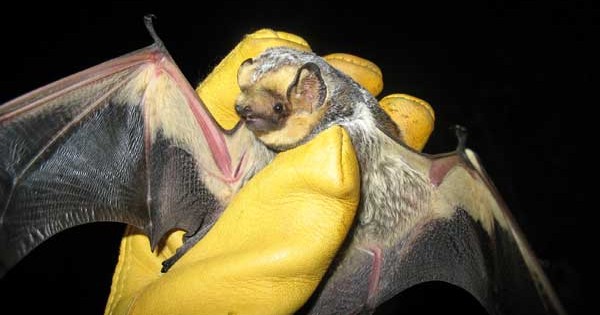
A row of wind turbines, their blades slowly rotating, is a mesmerizing and majestic sight. The turbines are also friendly to the environment: they generate no carbon dioxide (a cause of climate change) or such polluting gases as sulfur dioxide, which can contribute to acid rain. They provide income to landowners, don’t drain natural resources, and require only nominal maintenance. By one measure, the global wind energy market grew by 10 percent in 2012.
For birds and for bats, though, wind turbines are more of a bane than a boon. Almost half a million birds are killed every year in the United States after smacking into the blades, according to the U.S. Fish and Wildlife Service. Now a new study estimates that 600,000 bats were slaughtered by wind energy facilities in the United States in 2012. Sadder yet is the fact that many of these bat deaths could easily be prevented by a small change in the way that the turbines operate, says Mark A. Hayes, the author of the study.
Hayes, an ecologist at the University of Colorado at Denver, conducted a statistical analysis of published bat death data in order to estimate the total number of bats struck dead by turbines across the United States. About three-quarters of the bats killed, he told me by telephone, belong to three species called “migratory tree bats”—hoary bats, eastern red bats, and silver-haired bats—which, during autumn nights, migrate south across hundreds or thousands of miles to warmer latitudes.
But bats don’t like to fly in windy conditions, Hayes says, and therein lies the solution. Wind turbines are currently designed to begin rotating and generating electricity for the grid when the wind speed reaches nine miles per hour, a level known as the “cut-in speed.” By increasing this speed by a modest amount—to 15 or 16 miles per hour—“experiments have shown recently that you can reduce bat fatalities by 45 to 90 percent,” Hays says. “This a solvable problem.”
At higher wind speeds, fewer bats are flying about, so increasing the turbine cut-in speed at night, and only in the autumn months, would have minimal economic impact on companies’ revenue, according to Hayes. Bats themselves have a major impact on the economy. “They consume huge amounts of nocturnal insects, and in some cases they have a very substantial impact on consumption of agricultural crop pests,” Hayes explains. “In the southwest, where you see these beautiful cacti [in] very dry landscapes, often bats are one of the primary pollinators of those plants.”
It’s not clear whether wind turbines are endangering bat populations, especially since wildlife biologists have no easy way of estimating their numbers: the mammals are secretive, nesting in caves and abandoned mines and migrating at night. Yet turbines are undeniably a danger to bats, according to Paul Cryan, a research biologist at the U.S. Geological Survey in Fort Collins, Colorado. “In some parts of the country,” he writes in the journal Environmental Law, “bat researchers who only rarely catch hoary bats in the wild can now walk beneath turbines at certain wind energy facilities during autumn and find more dead hoary bats on the ground in a few weeks than they have caught during their entire careers.”
On Science will resume in January.

